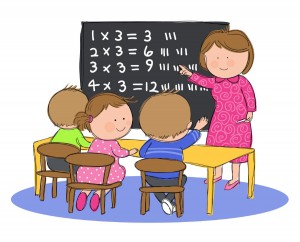Balanced math programs are not something new. Balanced math programs have always taught the fundamentals of math.
Many years ago, the board I teach for released an excellent poster outlining their approach to balanced math. The poster consisted of the importance of teaching: attitudes to math, approaches to instruction/assessment, teaching through problem solving, purposeful practice, basic facts and operational skills, and purposeful use of resources. When I saw the poster I was thrilled to see math pedagogy that aligned with my own teaching practice.
I have taught math from grade two to university level. Regardless of the grade or level of math, I believe there are four fundamental pillars in math instruction:
- Real world applications: Math instruction needs to connect to the real world – here students see the purpose of learning math such as measuring the diagonals of a door to ensure it is squarely/correctly installed or calculating how much paint you need to paint a room.
- Problem solving: Math should be taught with problem solving – problem solving adds complexity in applying math facts and operations skills within context and especially when connected to the real world.
- Practice to develop automaticity: Practicing addition and multiplication facts is not the most exciting part of math but without knowing them, students have to use more of their working memory to figure out the facts. This use of working memory/executive function leaves less space for working on the math that is in front of the student.
- Manipulatives/hands-on math: Manipulatives are not just for primary or junior grades, all students need them to make sense of abstract math concepts. I used math manipulatives to teach grade 8 students how to solve algebraic equations. Once the students did this with the manipulatives, they could work out the problems on paper. Even when I took university math courses, I always drew pictures of the math problem so I could understand my task better.
Other boards of education are also promoting balanced math programs. These boards of education may give their math programs a different name, but essentially the programs are similar.
In 2018, jobs that require math pay more than jobs than do not require math. This is a key reason to learn math!
These jobs include scientist, engineer, technologist, electronics specialist, robotics engineer, economist, game designer, roller coaster designer, animator, pilot, sports announcer, professional photographer, financial planner/analyst, cryptographer, research analyst, accountant, lawyer, marketing researcher, real estate agent, software designer/tester, global warming specialist, professional cook, and math teacher.
Math is important to students’ lives. It helps students make sense of the world as well as ways to figure out practical things like managing their money, doing home renovations, and making sense of their cell phone bills.
Do math, teach math, explore math.
If you know of anymore resources to share, please comment below so I can check them out!
Collaboratively Yours,
Deb Weston
More Information
Ford wants to get back to basics with math — but educators say balance is best
SEEING AS UNDERSTANDING: The Importance of Visual Mathematics for our Brain and Learning
York Region District School Board Comprehensive Math Program
Peel District School Board Balance Math Instruction K-12 Program
Why is it important to study math?
Math Resources for Parents and Teachers
Peel District School Board Parent Guide to Learning Math Today

